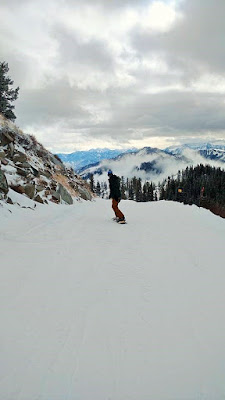(Brighton)
A couple of weeks ago, Mike and I went out to Salt Lake City, Utah with Samantha and Alex to visit our cousin, Megan, and her husband, Michael. We planned on a quick 3 day trip jam-packed with downhill skiing. Mike had never really skied at all before, but had snowboarded at a few local northern Michigan resorts. I had not been downhill since at least high school. Needless to say, we didn't have any gear, or expectations. We just wanted to spend a few fun days on the snow before cross country ski season kicked into high gear at the first of the year. By skiing this early in the season, we were able to avoid the crowds, and ski a lot of fresh snow. We really enjoyed such a fun trip with family, and were sad to see it end so soon.
(The view from our walk on our day off)
After our "last day" of skiing we went back to Megan's house, realized our early morning flight was cancelled due to weather, and we now had two more days to enjoy the mountains! By the time we made our way back to Michigan we had experienced all four of the Cottonwoods ski resorts- Alta, Snowbird, Brighton, and Solitude. Having the opportunity to hit all four we definitely had to do a ranking. The group was pretty much in consensus, although we are all open to some more testing!
4. Snowbird
(Mike at the top)
For our first day in Utah, we chose Snowbird, mainly because the lift to the top of the mountain was open, and Mike really wanted to snowboard at 11,000 feet. Megan and Michael were both working and said this wasn't their favorite resort, so they didn't mind that we went without them. The rental fees were the highest of the whole week, and while it looked like it had some good easy runs for us to start on, anything that wasn't a black diamond (hard) just acted as a connector trail, instead of being fun to ski on it's own. Samantha and Alex didn't want to attempt anything too challenging as they found their ski legs, so they ended up having to bus around to different lifts to ski the different areas while avoiding the harder trails. For a more accomplished skier, this may be the place to go, but for us it just wasn't great.
The weather deteriorated throughout the day, and for our last run Mike and I finally got the nerve to head to the top of the mountain for the lone blue (intermediate) intermediate run that went all the way down, and we were so nervous we would miss the signs due to low visibility and have to scale down a cliff that we couldn't even enjoy it until the bottom half of the mountain where we had been skiing all day.
If we had come later in the week, and on a day with better weather we may have enjoyed it more. I don't know if we will try this one again, but it definitely seemed to be the biggest hit with the people back home who have been to Salt Lake City to ski.
3. Solitude
Solitude was our "bonus" ski day. Megan and Michael were again at work, but had said this resort was fun although not their favorite. Having three days of skiing under our belt, and a rest day the day before (we were skiing 5 hours a day, and with no prior skiing that puts some wear on the legs!), we were confident in trying this new hill.
The weather was probably the nicest of our trip, but we found Solitude had groomed almost all of the runs, which just isn't as fun as the powder we had been skiing at the other resorts. Most of the trails here were in the wide open and straight down, so they weren't as pretty. Because all of the runs went straight down the hill they were hard- mountains are steep! Solitude also had the most moguls, which I like in short spurts, but it definitely made it challenging.
This area also seemed most prone to avalanche, with crews blowing out snow on some areas of the mountain, and other areas where snow had fallen down the mountain were almost bare, even with the four foot of base snow. By waiting until the last day of our trip, they did open the top of the mountain, so Mike and I skied the long runs all day, and did have a lot of fun. Samantha and Alex didn't enjoy this one so much because the skill jump between the green (easy) and blue runs made it hard to find something fun and challenging.
2. Alta
(The whole crew- Michael, Megan, Alex, Samantha, Rebecca, & Mike)
Mike and I tried a few black diamond sections here, and we didn't crash too many times. We liked the mogul sections with the powder, although the visibility made them a little tricky at times. Samantha and Alex found some easier trails that went through the woods and reminded us of cross country trails back home. Even the easiest runs were fun to ski, and had side areas where you could practice moguls and jumps.
1. Brighton
We had a perfect amount of fresh powder, and very few trails were groomed. It was fun skiing the mogul runs and picking up speed without being terrified of an icy crash. Alex and Samantha loved an easy run through the woods that also had some small off-shoots with jumps. Even though some of the other mountains were higher, the flow of the trails allowed Mike and I to ski nearly half an hour without having to get back on a chairlift. Brighton was also home to our favorite individual trail sections. We skied until the lifts closed and we can't wait to go back for more.



























